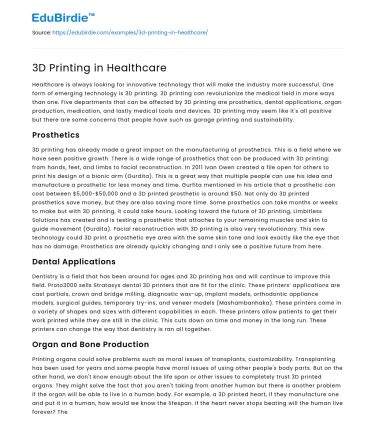Healthcare is always looking for innovative technology that will make the industry more successful. One form of emerging technology is 3D printing. 3D printing can revolutionize the medical field in more ways than one. Five departments that can be affected by 3D printing are prosthetics, dental applications, organ production, medication, and lastly medical tools and devices. 3D printing may seem like it's all positive but there are some concerns that people have such as garage printing and sustainability.
Prosthetics
3D printing has already made a great impact on the manufacturing of prosthetics. This is a field where we have seen positive growth. There is a wide range of prosthetics that can be produced with 3D printing: from hands, feet, and limbs to facial reconstruction. In 2011 Ivan Owen created a file open for others to print his design of a bionic arm (Gurdita). This is a great way that multiple people can use his idea and manufacture a prosthetic for less money and time. Gurfita mentioned in his article that a prosthetic can cost between $5,000-$50,000 and a 3D printed prosthetic is around $50. Not only do 3D printed prosthetics save money, but they are also saving more time. Some prosthetics can take months or weeks to make but with 3D printing, it could take hours. Looking toward the future of 3D printing, Limbitless Solutions has created and is testing a prosthetic that attaches to your remaining muscles and skin to guide movement (Gurdita). Facial reconstruction with 3D printing is also very revolutionary. This new technology could 3D print a prosthetic eye area with the same skin tone and look exactly like the eye that has no damage. Prosthetics are already quickly changing and I only see a positive future from here.
Save your time!
We can take care of your essay
- Proper editing and formatting
- Free revision, title page, and bibliography
- Flexible prices and money-back guarantee
Dental Applications
Dentistry is a field that has been around for ages and 3D printing has and will continue to improve this field. Proto3000 sells Stratasys dental 3D printers that are fit for the clinic. These printers’ applications are cast partials, crown and bridge milling, diagnostic wax-up, implant models, orthodontic appliance models, surgical guides, temporary try-ins, and veneer models (Mashambanhaka). These printers come in a variety of shapes and sizes with different capabilities in each. These printers allow patients to get their work printed while they are still in the clinic. This cuts down on time and money in the long run. These printers can change the way that dentistry is ran all together.
Organ and Bone Production
Printing organs could solve problems such as moral issues of transplants, customizability. Transplanting has been used for years and some people have moral issues of using other people's body parts. But on the other hand, we don't know enough about the life span or other issues to completely trust 3D printed organs. They might solve the fact that you aren't taking from another human but there is another problem if the organ will be able to live in a human body. For example, a 3D printed heart, if they manufacture one and put it in a human, how would we know the lifespan. If the heart never stops beating will the human live forever? There are many unanswered questions like this one that needs to be tested and answered before 3D printing organs can be mainstream. Other things like skin have already been made. Researchers have used the printed skin to test new drugs but haven't used them on humans yet.
Medication
The mission of 3D printing medication is the purpose of personalization. So, they can tailor the size and shape so it's easy for the patient to take the pill. Also, they are creating pills with high dosages. The first 3D printed pill approved by the FDA was Spitzam which is a pill for epilepsy (3D Printing Drugs). If doctors could 3D print drugs in office, then there would be little use for pharmacies. They could skip a step and zoom out by giving the prescriptions at the clinic. This would save a lot of time for the doctor and the patient. Other people have been trying to print pills that are personalized to you and everything you need in one pill (3D Printing Drugs). The main innovation with pill printing is custom printing in the clinic.
Tools
The benefit of 3D printing tools for surgical procedures are time, money, the ability to customize and patient safety (Mashambanhaka). It would take less time to 3D print a tool, which takes a couple of hours, rather than ordering a tool and receiving it in the mail in weeks. 3D printing also saves money. When clinics need sterile tools, they have to order new ones which can eventually get very expensive. 3D printing allows them to make a sterile tool in the office at a much lower price. With ordering a standard tool you don't get any room to tailor it for the patient or the doctors' preferred use. With 3D printing, a doctor could get anything he or she wants.
3D Printing Is Also
There are many benefits to 3D printing that revolutionized the way the medical field works. There are also some concerns and controversies that go along with the positives. Garage printing is a huge issue especially in the area of printing medication. If anyone can get ahold of a certain file then they could know how to print pills. If anyone can print some of these medical resources then things could get dangerous. I think that the benefits outweigh the negatives to 3D printing in healthcare. If we can further perfect 3D printing in the medical field there would be far greater things to come.






 Stuck on your essay?
Stuck on your essay?

